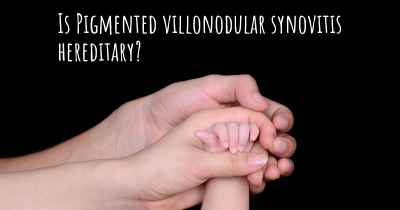What is the history of Pigmented villonodular synovitis?
When was Pigmented villonodular synovitis discovered? What is the story of this discovery? Was it coincidence or not?

Pigmented villonodular synovitis (PVNS) is a rare benign condition that affects the synovial lining of joints, tendon sheaths, and bursae. It is characterized by the overgrowth of the synovial tissue, leading to the formation of nodules and the accumulation of pigmented cells. PVNS can occur in any joint, but it most commonly affects the knee.
The history of PVNS dates back to the late 19th century when it was first described by Jaffe and Lichtenstein in 1941. However, the condition was not well understood at that time, and it was often misdiagnosed as other joint disorders. It was not until the mid-20th century that further research shed light on the nature and pathology of PVNS.
In 1949, Dr. John J. Conley, an orthopedic surgeon, published a seminal paper on PVNS, where he coined the term "pigmented villonodular synovitis." He described the condition as a proliferative disorder of the synovium characterized by the presence of pigmented cells. Dr. Conley's work helped establish PVNS as a distinct clinical entity.
In the following decades, researchers and clinicians made significant progress in understanding PVNS. They discovered that PVNS can occur in two forms: localized and diffuse. Localized PVNS typically affects a single joint, while diffuse PVNS involves multiple joints or spreads beyond the synovial lining. The diffuse form is more aggressive and can cause more severe symptoms.
In the 1980s, advancements in imaging techniques, such as magnetic resonance imaging (MRI), allowed for better visualization and diagnosis of PVNS. This led to improved accuracy in identifying the condition and distinguishing it from other joint disorders. Prior to this, PVNS was often misdiagnosed as rheumatoid arthritis or other inflammatory conditions.
In the late 1990s and early 2000s, researchers began to unravel the genetic basis of PVNS. They discovered that a specific genetic mutation, known as the translocation t(1;2)(p13;q37), is present in a significant proportion of PVNS cases. This translocation leads to the fusion of two genes, COL6A3 and CSF1, resulting in the overproduction of colony-stimulating factor 1 (CSF-1). The excess CSF-1 promotes the growth of synovial tissue, contributing to the development of PVNS.
More recently, studies have focused on improving treatment options for PVNS. Surgical intervention, such as synovectomy (removal of the synovial lining), has been the primary treatment approach. However, recurrence rates have been relatively high, especially in cases of diffuse PVNS. As a result, researchers have explored alternative therapies, including targeted drug treatments.
In 2019, the U.S. Food and Drug Administration (FDA) approved the use of pexidartinib, a tyrosine kinase inhibitor, for the treatment of adult patients with symptomatic PVNS. Pexidartinib targets the abnormal CSF-1 receptor, inhibiting the signaling pathway that promotes the growth of synovial tissue. This targeted therapy has shown promising results in reducing tumor size and improving symptoms in PVNS patients.
Overall, the history of PVNS has seen significant advancements in understanding its pathology, diagnosis, and treatment. From its initial description as a proliferative disorder of the synovium to the identification of genetic mutations and the development of targeted therapies, researchers and clinicians have made great strides in managing this rare joint condition.








